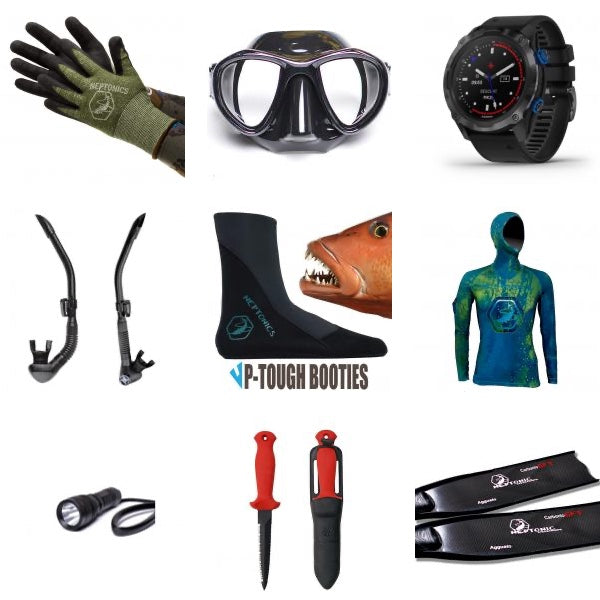
Essential Spearfishing Gear - What is in Our Dive Bag
Every new diver always has some questions about essential spearfishing gear. This blog will go over the basics of what you would need to start off spearfishing. We also go over what you may want as you get more into the sport. This is what you will find in a Neptonics staff member's dive bag for a normal day of diving.
Masks, Fins, Snorkels, Booties
These are some of the most important pieces of basic equipment. Getting a quality mask is one of the keys to having a good dive day. Fins make a huge difference in a divers ability to dive efficiently. Snorkels are under appreciated for being essential spearfishing equipment. Booties protect your feet and make multiple days of diving safer.
Mask Fitting
Getting the right mask is critical for enjoying your dive trips. If you can, you should try on the mask first to make sure it is comfortable. If you are freediving or spearfishing, it comes in handy to get a low volume mask. Low volume refers to the amount of air space in the mask. The lower the volume of the mask, the less air you have to use from your lungs to equalize the mask. Comfort is the most important element of a mask. When you try on the mask, make sure to push the mask against your face to see where the frame of the mask would come in contact with your face under pressure. If there are any uncomfortable points of contact with the mask on your face, you should consider a different mask. A mask that fits well without leaks is essential for spearfishing.
Fins
Fins are the only piece of equipment that can instantly improve a divers ability to dive deeper or more efficiently. Currently, there are three types of fins available on the market. These types are differentiated by the type of material the fin blade is constructed of. Those materials are plastic, composite fiberglass, and carbon fiber. If you are just starting out in the sport, you may want to consider the plastic fins as a starting point. They are durable and come at a good price point. Plastic fins are more efficient than your standard snorkeling fins or scuba fins, but there is also lots of room for improvement on efficiency. That is where composite fiberglass and carbon fiber fins come into the conversation. For a break down of kick cycle tests, check out this other blog post. Do your research, and test out a few pairs of fins if you can.
Snorkels
Freediving snorkels are generally pretty simple. You can get a snorkel that is more expensive, but there are some features you should be aware of. A purge valve has its benefits on a snorkel, but is is a moving part that wears out over time. Many manufacturers offer replacement parts for these types of purge valves, so it is not a huge hassle to replace them, but it may be worth keeping a spare in your dive bag if that is a feature you prefer. Many Freedivers prefer a simple j-snorkel that does not have a purge valve. The way you clear that type of snorkel is to just use more force from your lungs to force the water out of the snorkel. These are simple, durable, and inexpensive.
Booties
A good pair of booties can save your feet from terrible blisters. Booties can also help fill in an ill-fitting pair of footpockets on your freediving fins. Ideally, your fin blades are an extension of your foot. A proper fit with booties can make that happen. Booties prevent blisters by keeping a soft padding between your feet and the abrasive rubber of a foot pocket. When you are swimming, you are putting a great amount of force on your feet and any give in the foot pocket with respect to your foot can cause chafing and blistering. This is compounded by your skin getting soft while submerged for an extended period of time. If you want to keep your feet in good condition, booties are without a doubt essential spearfishing gear.
Wetsuits
Spearfishing wetsuits do a lot more than just keep a freediver or spearfisher warm. They also keep us protected from abrasion in the water. Divers spend a surprising amount of time on the bottom of the ocean. There are rocks, corals, and countless other things that can scrape up a diver. If you are spearfishing, there is also the consideration that fish themselves tend to be pointy. Most fish have spines that can be very painful on divers, and they have a way of wriggling while being handled that always seems to guarantee getting stabbed with their spines. A thick neoprene wetsuit helps prevent that. Wetsuits also help to ensure buoyancy. Proper buoyancy is critical to diving safely. A diver should be positively buoyant at the surface, and a wetsuit can help accomplish that. All of these reasons make wetsuits essential spearfishing gear.
Weight Belts
Weight belts are the other side of the buoyancy question. When paired with a wetsuit, they should allow the diver to be negatively buoyant at the bottom of their dive, and neutrally buoyant at about 30 feet (10 meters). This desired buoyancy is based on shallow water blackout statistics. You need to ballast yourself with lead weight to dive effectively and efficiently, especially with thicker wetsuits. New 5mm and 7mm wetsuits are so buoyant that it is almost impossible to dive underwater without ballasting from a weight belt and lead.
